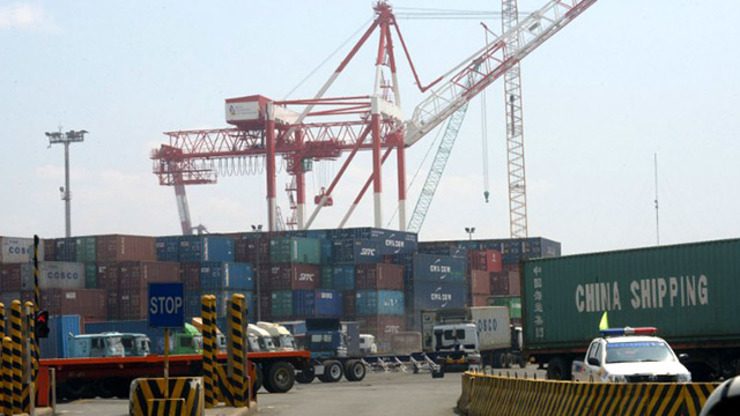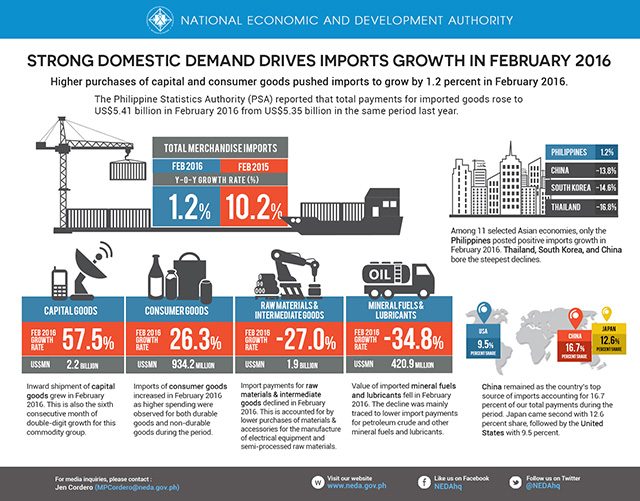SUMMARY
This is AI generated summarization, which may have errors. For context, always refer to the full article.

MANILA, Philippines – Philippine imports grew by 1.2% in February, led by the continued purchases of capital goods, according to the National Economic and Development Authority (NEDA).
While still positive, the rate of growth is far slower than the surge in growth posted in January which reversed a steep decline in December 2015.
Total payments for imported goods rose to $5.41 billion in February from $5.35 billion in the same period last year, the Philippine Statistics Authority (PSA) reported on Tuesday, April 26.
“This growth indicates that amid a global economic slowdown, domestic demand, especially investments, remains strong. This will likely continue to drive imports growth within the short term,” said Socioeconomic Planning Secretary Emmanuel Esguerra.
He also pointed out that among 11 selected Asian economies, only the Philippines posted positive imports growth in February, with Thailand, South Korea, and China recording the biggest declines.
He said, however, that the government’s spending program “needs to gain traction particularly in the infrastructure sector, which will require higher importation.”
“Bottlenecks in Manila’s ports must also be given serious attention to further bring down the cost of imported goods for domestic businesses and consumers,” said Esguerra.

Philippine-bound shipment of capital goods grew by 57.5% in February, totaling $2.2 billion worth of imports. This is the 6th consecutive month of double-digit growth for this commodity group.
This indicates strong economic activity supported by the country’s strong macroeconomic performance, Esguerra said.
He added: “The continued strong imports growth of capital goods shows the country’s attractiveness to both local and foreign investors, particularly in the manufacturing sector.”
Imports of consumer goods increased by 26.3% to $934.2 million as higher spending was observed for both durable goods (39.4%) and non-durable goods (13.9%) during the period.
Purchases of raw materials and intermediate goods, and mineral fuels and lubricants decreased during the period.
China remained the country’s top source of imports, accounting for 16.7% of the Philippines’ total payments during the period. Japan was second with 12.6% share, followed by the United States with 9.5%. – Rappler.com
Add a comment
How does this make you feel?
![[EDITORIAL] Apat na taon na lang Ginoong Marcos, ‘di na puwede ang papetiks-petiks](https://www.rappler.com/tachyon/2024/07/animated-bongbong-marcos-2024-sona-day-carousel.jpg?resize=257%2C257&crop=280px%2C0px%2C720px%2C720px)
![[In This Economy] Delulunomics: Kailan magiging upper-middle income country ang Pilipinas?](https://www.rappler.com/tachyon/2024/07/in-this-economy-upper-middle-income-country.jpg?resize=257%2C257&crop=421px%2C0px%2C1080px%2C1080px)

![[EDITORIAL] Marcos Year 2: Hilong-talilong](https://www.rappler.com/tachyon/2024/07/animated-bongbong-marcos-2nd-sona-carousel.jpg?resize=257%2C257&crop=136px%2C0px%2C720px%2C720px)
![[Newspoint] A fighting presence](https://www.rappler.com/tachyon/2024/07/thought-leaders-a-fighting-presence.jpg?resize=257%2C257&crop=441px%2C0px%2C1080px%2C1080px)
There are no comments yet. Add your comment to start the conversation.